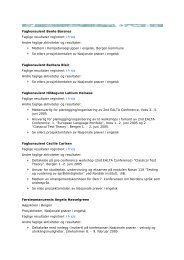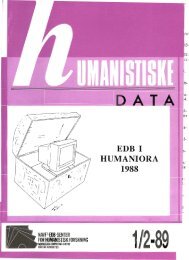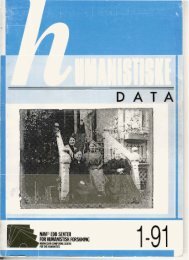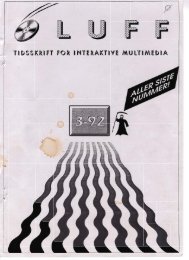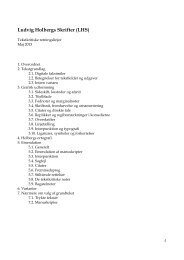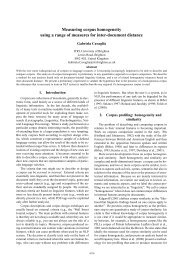1991:2 - Universitetet i Bergen
1991:2 - Universitetet i Bergen
1991:2 - Universitetet i Bergen
You also want an ePaper? Increase the reach of your titles
YUMPU automatically turns print PDFs into web optimized ePapers that Google loves.
At Oxford we are planning to conduct a detliiled evaluation of the<br />
use of hypenext and multimedia for research and teaching in the<br />
humanities, concentrating on the users' perspeclive. We wi11 100k at<br />
issues such as:<br />
1. Whar happens when the user (researcher or student) reachec the<br />
end of the links, that is he or she navigates ai1 the material which<br />
is provided, ahen wants to find out more? How readily do they<br />
then movc to more traditional meihods of enquiry, ide. ptinted<br />
books and journaIs7<br />
2. A hypertext system often contains one person's interpretation of a<br />
Iiterary text. or other data. Other interprehtions may be different.<br />
Can a hypertext intetpretation be easily compared with one or more<br />
published in more mditional foms? Or does the medium influence<br />
the users' PccepDnce of the inierpreurion?<br />
3. Hypertext really onIy provides a one-way flow of information. It<br />
can be argued hat books do this too, but because of the availability<br />
of so much interacrive software - even simple drill and practice<br />
programs - Lhere is sorne expectation that the computer should<br />
aIways provide interaction. In a hypertext system, how easiIy can<br />
the user interact and add his or her own interpretation to the data?<br />
As a one-way fiow of information it is mote dynamic than a book,<br />
but does it really provide what people have come lo expect from<br />
a computer?<br />
4. Screen design is really crucial for hypertext systems which mix<br />
text and graphics. The standard Macintosh has a small screen; It<br />
provides o lot of easy to use fecilities for changing fonts etc.<br />
which can tempt the beginner inta what has bccome known as<br />
'fonritisy, using toe many fonts to design somethimg which is too<br />
difficult to read or fellow rhrough. Largcr syncms like Intermedia<br />
allow many windows supcrirnposed on each other and agun fie<br />
screen can very rapidly bacome cluttered and diificult to interpret<br />
without careful design. What are the ideal characteriskics of screcn<br />
design, bearing in mind the type af rnatcrial which is bcing<br />
presented?<br />
5. Most importantly, what arc zhc capabilisies of hypertext sysrems<br />
for modeIling the complexities of humanitles data? On ihe face of<br />
i4 hypertext docs secm to provide a way forward for modelling<br />
humanities data, since it does not impose such rigid structurc on<br />
the dala. It makes the software fit the data and cmtcs an interactivc<br />
environment for exploration of Lhe dala. But can it really provide<br />
all the navigation path which scholars need withaut confusing<br />
them at Lhc same time?<br />
HUMANISIISKE DATA 291




